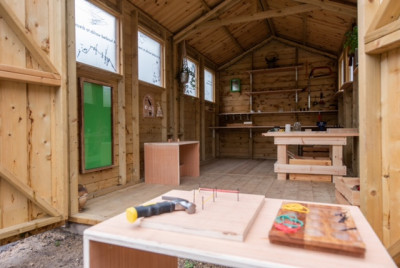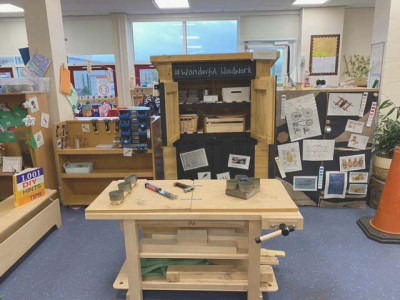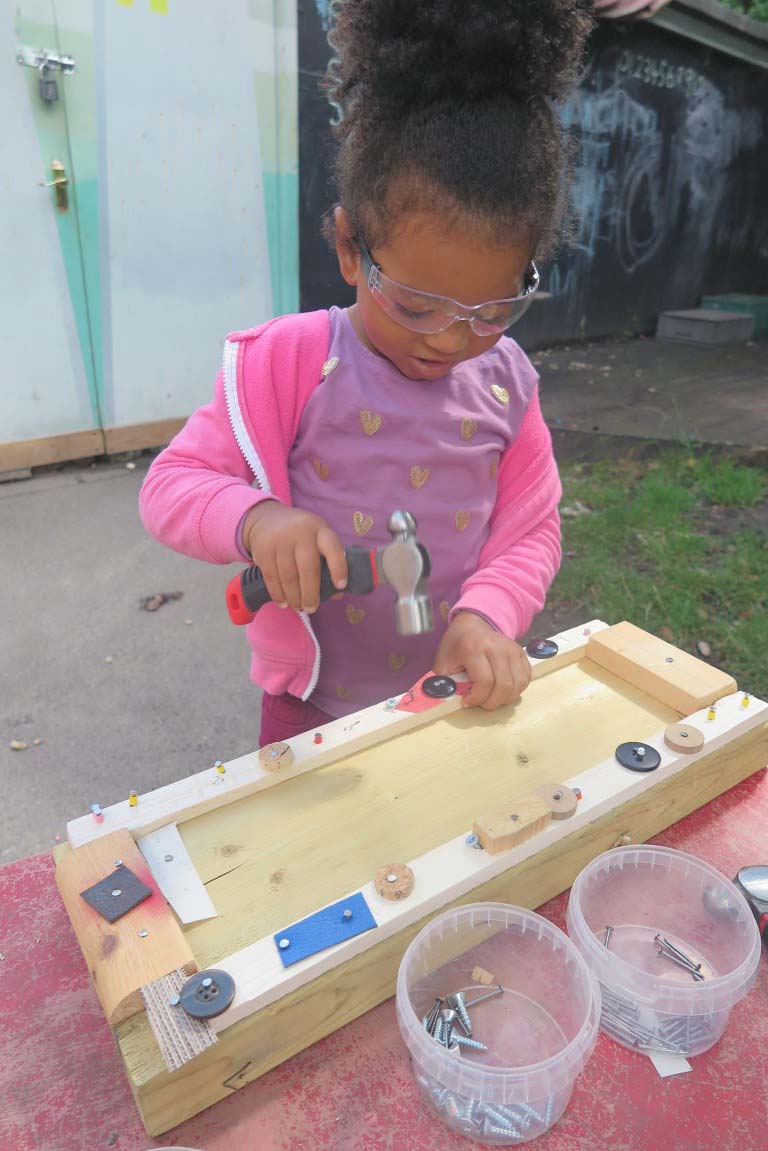
Millie (4) has a satisfied radiant glow. She is admiring her work after spending two hours in the woodwork area where she has been engrossed in constructing a bed for a princess. It was a complex process; first designing then making, adapting, and resolving problems as she went. She used creative and critical thinking skills and applied her mathematical thinking skills to ensure the legs were the same length. Millie finished by elaborately decorating the bed with beads and buttons. Yes, Millie made a bed, but what was really ‘made’ was within Millie. Her sense of agency flourished as she put her ideas into action and her confidence grew as she mastered the woodworking tools. New neural connections and pathways will have been established during her creative and critical thinking experience. This is the wonder of woodwork.
The value of woodwork in early childhood education
There is something special about woodwork. It’s so different from other activities. The smell and feel of wood, using real tools, working with a natural material, the sounds of hammering and sawing, hands and minds working together to express their imagination and to solve problems, the use of strength and coordination: all go together to captivate young children’s interest.
These are exciting times. We are seeing a surge of interest in woodwork within early childhood education across the globe. In some places they’re starting from scratch, in others, it’s a case of dusting down the workbench and digging out the tools after many years of neglect.
It’s exciting because the benefits of woodwork run deep. Teachers who provide woodwork sessions regularly observe exceptional levels of sustained engagement, with deep focus, concentration, and perseverance with challenging tasks – especially with complex problem-solving. It is not unusual for children to spend all morning at the woodwork bench.
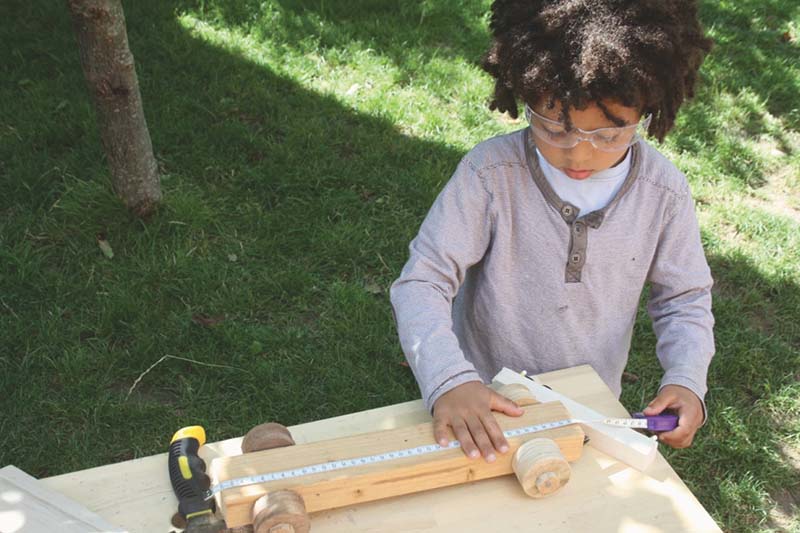
Woodwork engages hands, minds and hearts
When we analyse a woodworking session, it is extraordinary to see how much learning is involved. It’s truly holistic; encompassing all areas of learning and development and inviting connections between different aspects of learning. In this sense, woodwork can be central to the curriculum. It incorporates mathematical thinking, scientific investigation, developing knowledge of technology, a deepening understanding of the world, as well as physical development and coordination, communication and language, and personal and social development. This is evidenced by the interim research findings from ‘The Big Bang Research Project’.
With woodwork, children can develop their learning at their own pace and find their own challenges. Once they have mastered the basic skills, they can move into open-ended exploration; tinkering, exploring possibilities, and then starting to make unique creations drawing on previous experiences and their emerging knowledge of tools to create new forms.
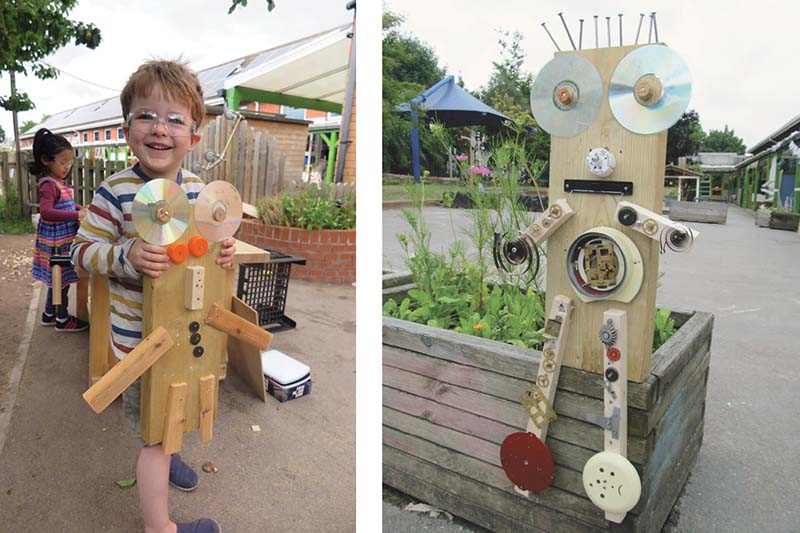
The sustainable beauty of wood
Woodwork helps counteract the current culture of “consume and dispose” by developing an understanding of the value of making and repairing. Children discover how to re-purpose materials, by making models from a selection of recycled wood and other items. By understanding where wood comes from and seeing the beauty of wood, children will develop respect for natural materials and feel inspired to take responsibility for their environment.
Woodwork for all
To ensure equal opportunities, it’s important to introduce tools to all of the children so they feel comfortable in the woodwork area. That way, they can make an informed decision about whether they want to participate. It’s important to acknowledge there is often gender stereotyping around woodwork - there’s an assumption only boys will be interested. However, after this initial introduction, we notice no gender difference. It’s hard to become what you don’t see, so support equality by having books in your early years space with positive role models using tools.
Woodwork captures children’s curiosity, and it has been successful in significantly engaging children from more disadvantaged backgrounds who are less confident and have difficulty focusing. Giving children a high level of trust and responsibility is empowering, and woodwork has been key in unlocking some children’s learning and boosting their self-esteem and confidence.
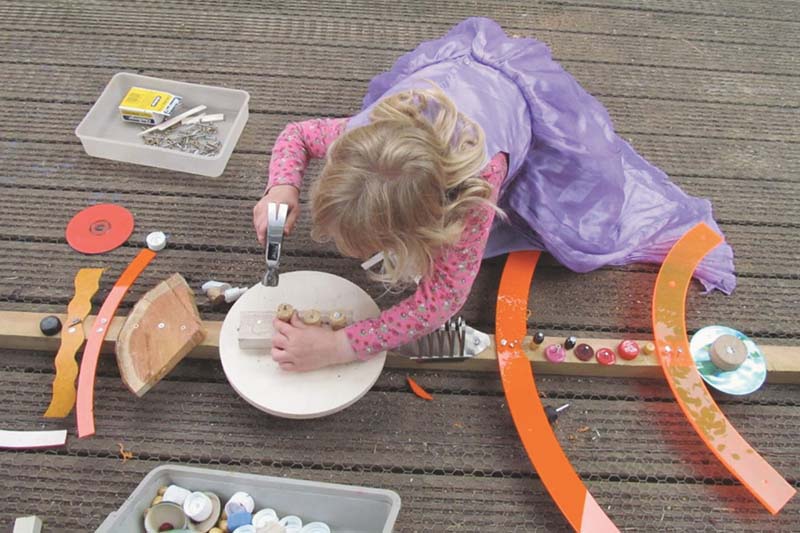
Setting up a woodwork practice
Woodwork is perhaps one of the more difficult activities to set up, but it’s worth the effort. Tools, wood, and other materials such as corks and bottle tops, nails and screws, sandpaper, safety glasses, and a workbench all need to be sourced. A sturdy workbench is essential because wood must be clamped tight in a vice before sawing. Only a few tools are essential; stubby hammers, stubby screwdrivers, hand-drills, and pull saws. It’s important to have opportunities for incremental progression to meet the developmental needs of each child. We need to avoid giving children too many challenges, too soon.
Introduce the tools in small groups, (1:3 for 3-4yrs, 1:4 for 4-5 years). For younger children, start with softer materials, such as balsa wood, to ensure a more positive initial experience. Gradually increase the level of challenge; start with small nails, and thin wood to join to blocks, before slowly introducing a wider selection of wood sizes and larger nails.
As children gain confidence, woodwork can become continuous provision or made available to larger groups at specific times. The continuous provision gives children more choice and autonomy, but it only works well if you have enough resources - and children can get through resources quickly! What’s important is that the provision is a rich experience with enough resources to allow complexity in thinking.
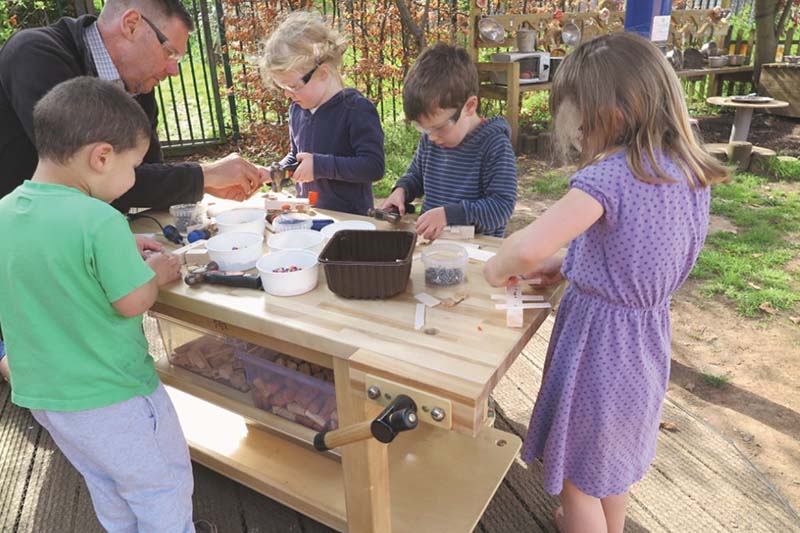
Experiencing risk in a controlled, safe environment
If you’ve never done woodwork before it’s natural to feel a little apprehensive. It’s easy to conjure up images of accidents with children wielding saws! But those who have embraced woodwork find it’s surprisingly safe. Woodwork is low-risk when introduced correctly and basic safety measures are put in place. I have been providing woodworking for young children for over 25 years with no significant incidents. I would advise introducing woodwork from 3-4yrs.
We are now seeing a more balanced attitude to risk. Health and safety measures should enable children to experience new opportunities safely, not deny them. It is important for children to experience risk within a controlled environment so they can learn to understand and manage risk. This way they learn to self-manage and make decisions and judgements to better protect themselves in the future.
Of course, health and safety does need to be taken seriously. It is our prime responsibility as educators to ensure the physical and emotional care of our children. We need to put in measures to reduce risk, such as using the most appropriate tools.
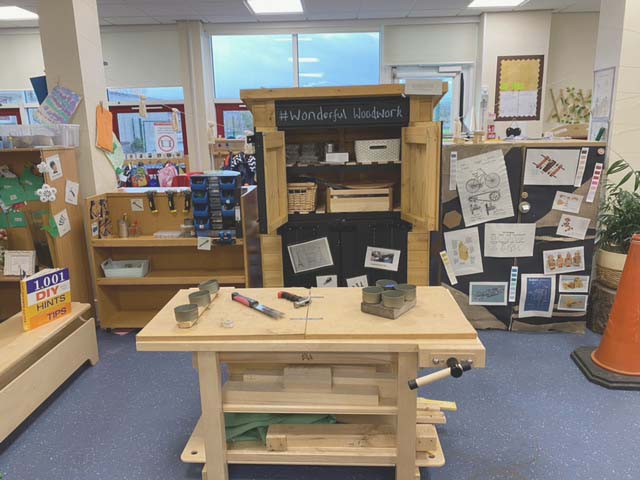
Woodwork health and safety
- Safety glasses – always wear safety glasses to eliminate the risk of eye injury. Children are more comfortable and are safer in safety glasses than chunky goggles.
- Ensure children are given instruction on the correct use of all tools. Take time to discuss the tools together and draw attention to hazards. Children need to understand why health and safety measures are put in place.
- Monitor sawing with a 1:1 ratio. Make sure no children are watching from in front of the sawing area. Have an educator stand in this area to prevent other children from getting close to the saw. Pull saws (held with both hands) are much easier and safer for young children. After use, put the saw out of reach. Wood is always to be clamped in a vice when being sawn and checked by an adult to make sure it’s tight.
- Hammering - after the gentle taps to get the nail standing up, hold the wood well away from the nail before hammering hard. Embed this practice from day one.
- Check wood for splinters. We need to limit exposure to splinters. Avoid rough splintery wood. Sand the edge after sawing if it’s rough.
- Children should always be monitored. Initially with close supervision then when children are confident using tools, ratios can be relaxed and they can work independently (except for sawing, which is always done with a 1:1 ratio). A staff member should always remain within the line of vision of the woodworking area.

Empowering children to shape their world
Woodwork is a symbolic language of shape, form, and space. It encompasses a way of working that develops over time as children express their ideas with increasing fluency and complexity. As children tinker and experiment and then construct, create, and explore narratives, these experiences can combine to build rich foundations for children’s healthy emotional, physical, and cognitive development. Woodwork can promote an experimental mindset and at the workbench children ‘become’ innovators, makers, sculptors, tinkerers, engineers, and architects.
As children make with wood, they are learning skills that will empower them to shape their world.
Woodwork is certainly a very popular activity and incorporates so much learning; a real win-win. It would be wonderful for all children to have the opportunity to flourish at the woodwork bench.
![]()
Pete Moorhouse is an early years creative consultant and artist educator. He is an honorary research fellow at the Graduate School of Education at the University of Bristol. He researches creative and critical thinking in early years, regularly presenting research at international conferences. Pete is an associate trainer for early education and delivers training both in the UK and overseas. An endorsed Froebel tutor, his work is centred around developing children's creativity and his practice is inspired by Froebelian principles and practice in Reggio Emilia. Pete is the UK’s leading authority on woodwork in early years education and has written several books and journal articles, including ‘Learning Through Woodwork’ (Routledge) and Outdoor Learning. He is currently working on his latest book – ‘Creativity in Practice: Nurturing creative and critical thinking in early childhood education.’ Pete won the national award (2019) from the Creative Learning Guild for his work promoting creativity in education. He was awarded a Churchill Fellowship and is a Fellow of the Royal Society of Arts.
Get in contact with Pete - studio@petemoorhouse.co.uk
Links to further training and resources
- Professional development by Pete Moorhouse
- The Big Bang Research Project
- Book - Learning through woodwork by Pete Moorhouse
 Pete Moorhouse
Pete Moorhouse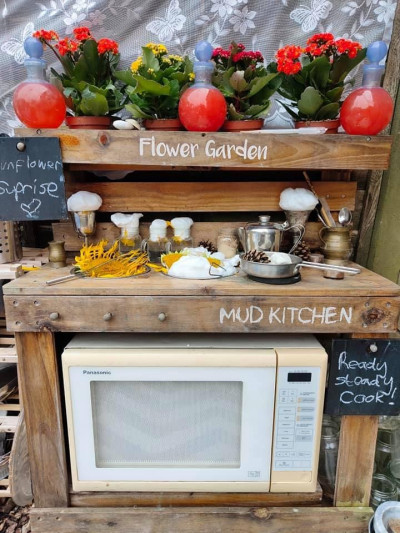
 Michelle Pratt
Michelle Pratt